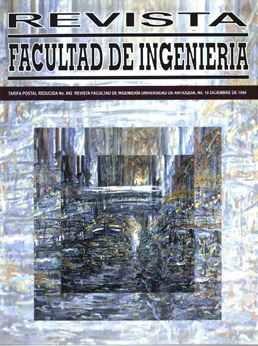Variación de la concentración del furadán en el perfil de un andisol
DOI:
https://doi.org/10.17533/udea.redin.325828Palabras clave:
Furadán, lixiviados, suelos, lisímetros, percolación, cromatografía líquida, contaminación, Carbofurán, plaguicidas, Andisol.Resumen
Con el objetivo de determinar el movimiento del Furadán en el suelo, se muestrearon las fases sólidas y líquidas de dos Andisoles ubicados bajo pasto y bajo bosque. El muestreo se hizo instalando un lisímetro en cada horizonte, luego se aplicaron 3 mi de Furadán disueltos en 6 litros de agua, equivalentes a una concentración de 181.1 mg/ml, en la superficie de los dos Andisoles. El monitoreo se realizó durante seis meses. Para extraer el Furadán de las fases líquida y sólida del suelo se usaron los métodos de extracción por fase sólida y extracción líquido-líquido, respectivamente. La cuantificación del Furadán se realizó por cromatografía líquida de alta resolución; la fase móvil empleada fue acetonitrilo -agua 75:25, el límite de cuantificación fue de 0.005 mg/ml. Se encontró movimiento del Furadán hasta 90 cm de profundidad y la máxima cantidad hallada en los lixiviados equivalió al 50 % del aplicado. Después de 61 días de la aplicación no se volvió a detectar el insecticida en los lisímetros. Al finalizar el experimento a los 97 días se encontraron cantidades muy pequeñas de Furadán en el suelo de dos horizontes de bosque.Descargas
Citas
CAMPER. N. D. et al. Biodegradation of carbofuran in prelreated and nonpretreated soils. In: Bull. Environ. Contam. Toxico l. Vol. 39. no.4. 1987. p. 571-578. DOI: https://doi.org/10.1007/BF01698447
CARO. J.H .. GLOTTELTY. O.E, FREEMAN. H.P. and TAYLOR. A.W. J. Ass. Offic. Anal. Chem. 56 (1973) 1319. DOI: https://doi.org/10.1093/jaoac/56.6.1319
EPA. "Methods for the Determination of Nonconventional Pesticides in Municipal and Industrial Wastewater" United States Environmental Protection Agency. revision 1. 1993.
GROU. E. and RADULESCU V .. J ofChrom. 260 (1988). 502-507 DOI: https://doi.org/10.1016/0021-9673(83)80061-2
ICA."Comercialización de Plaguicidas lmportación-Producción Ventas-Exportaciones".
División de Insumos Agrícolas Instituto Colombiano Agropecuario. Santafé de Bogotá. 1999.
INSTITUTO TECNOLOGICO GEOMINERO DE ESPAÑA. "Las Aguas Subterráneas y Los Plaguicidas". 1992
JARAMILLO J .. Daniel F." Andisoles del Oriente Antioqueño. Caracterización química y fenilidad". Universidad Nacional de Colombia. Medellín. 1995. 35 p.
MORI. H: et al.. "A high performance liquid chromatographic method for determi nation of ben f uracarb and carbof uran residues in soil and water" In: J. Pesticide Sci., No 12 ( 1987). 491-497 p. DOI: https://doi.org/10.1584/jpestics.12.491
MURRA Y B .. Me Bride. EnvironmentaJ chemistry of soils.
New York: Oxford University Press. 1994. P. 308-391.
SANABRIA. R. J .. "Modelo de simulación para el movimiento de productos químicos en el suelo". En Suelos Ecuatoriales. Vol. 18. No. 1 ( 1988). p 25-31.
SCHUSTER. R.and GRATZIELD-HÜSGEN. A. "HPLC analysis of pesticide traces in the ppt range" Hewlett-Packard Company, 1994. 8 p.
STOLPE NEAL. et. al.." lmponance of soil map detail in predicting pesticide moibility in terrace soils". In: Soil Science. Vol 163. No. 5 ( 1998). p. 394-403. DOI: https://doi.org/10.1097/00010694-199805000-00007
THAPAR. S. & BHUSHAN. R .. "Simultaneous determination of a mixture of organophosphorus and carbamate pesticides by high performance liquid chromatography". In: Biomedical Chromatography. Vol. 8, (1994), p. 153-57 DOI: https://doi.org/10.1002/bmc.1130080402
Descargas
Publicado
Cómo citar
Número
Sección
Licencia
Los artículos disponibles en la Revista Facultad de Ingeniería, Universidad de Antioquia están bajo la licencia Creative Commons Attribution BY-NC-SA 4.0.
Eres libre de:
Compartir — copiar y redistribuir el material en cualquier medio o formato
Adaptar : remezclar, transformar y construir sobre el material.
Bajo los siguientes términos:
Reconocimiento : debe otorgar el crédito correspondiente , proporcionar un enlace a la licencia e indicar si se realizaron cambios . Puede hacerlo de cualquier manera razonable, pero no de ninguna manera que sugiera que el licenciante lo respalda a usted o su uso.
No comercial : no puede utilizar el material con fines comerciales .
Compartir igual : si remezcla, transforma o construye a partir del material, debe distribuir sus contribuciones bajo la misma licencia que el original.
El material publicado por la revista puede ser distribuido, copiado y exhibido por terceros si se dan los respectivos créditos a la revista, sin ningún costo. No se puede obtener ningún beneficio comercial y las obras derivadas tienen que estar bajo los mismos términos de licencia que el trabajo original.










 Twitter
Twitter